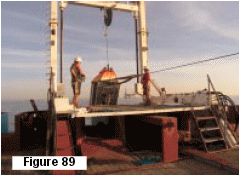Chapter 10
Offshore testing
Introduction
| INTRODUCTION 10.1 | |
| Further offshore, water depths are too great for jack-ups so vessels are used. Two types of geotechnical investigation can be performed with a vessel-based system: a seabed system or a drilling based system. For static operations such as drilling and down-hole CPTs, vessels with the means to stay stationary have to be used. This can be achieved by using mooring systems, or (more expensively) vessels with dynamic positioning capabilities. Drill ships need a moon-pool (a hole in the ship’s deck) so that the work can be carried out safely and efficiently. Occasionally a drill system will be mounted on a cantilever platform over the side. A heave compensation system is needed as well as a seabed reaction frame (clamped around the drill pipe) for the CPTs. This heavy compensation system is designed to keep the drill stationary relative to the seabed, enabling the vessel to move up and down with the swell. These systems allow drilling operations to be performed offshore and samples to be recovered, and down-hole CPT tests to be performed. | |
 | However, smaller seabed systems can be deployed from larger types of vessels. In essence only a barge or vessel with a suitable crane or A-frame is necessary. The selected vessel must have the ability to remain on station throughout the test either by anchoring or more commonly holding station using its bow and stern thrusters. Figure 89 shows a typical portal frame arrangement deploying a seabed resistivity system. |
|
